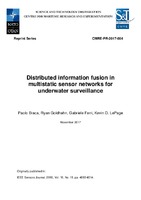| dc.description.abstract | Surveillance in antisubmarine warfare has traditionally been carried out by means of submarines or frigates with towed arrays. These techniques are manpower intensive. Alternative approaches have recently been suggested using distributed stationary and mobile sensors, such as autonomous underwater vehicles (AUVs). In contrast with the use of standard assets, these small, low-power, and mobile devices have limited processing and wireless communication capabilities. However, when deployed in a spatially separated network, these sensors can form an intelligent network achieving high performance with significant features of scalability, robustness, and reliability. The distributed information FUSION (DIFFUSION) strategy, in which the local information is shared among sensors, is one of the key aspects of this intelligent network. In this paper, we propose two DIFFUSION schemes, in which the information shared among sensors consists of: 1) contacts, generated by the local detection stage and 2) tracks, generated by the local tracking stage. In the first DIFFUSION scheme, contacts are combined at each nodes using the optimal Bayesian tracking based on the random finite set formulation. In the second DIFFUSION scheme, tracks are combined using the track-to-track association/fusion procedure, then a sequential decision based on the association events is exploited. A full validation of the DIFFUSION schemes is conducted by the NATO Science and Technology Organization - Centre for maritime research and experimentation during the sea trials Exercise Proud Manta 2012-2013 using real data. Performance metrics of DIFFUSION and of local tracking/detection strategies are also evaluated in terms of time-ontarget (ToT) and false alarm rate (FAR). We demonstrate the benefit of using DIFFUSION against the local non-cooperative strategies. In particular DIFFUSION improves the level of TOT (FAR) with respect to the local tracking/detection strategies. In particular, the TOT is increased over 90%-95% while the FAR is reduced of two order of magnitude. The problem of communication failures, data not available from the collaborative AUV during certain periods of time, is also investigated. The robustness of DIFFUSION with respect to these communication failures is demonstrated, and the related performance results are reported here. In particular, with 75% of communication failures the ToT is over 90%-95% with a relatively small increase of the FAR with respect to the case of perfect communication. | |
